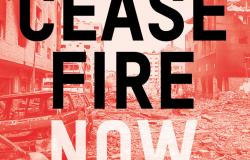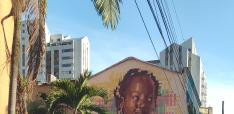Why a “humanitarian pause” or “humanitarian corridors” are simply not the answer in Gaza

This post by Oxfam’s Richard Stanforth and Magnus Corfixen first appeared on Oxfam’s Views and Voices blog.
Why are Oxfam and other humanitarian organisations not welcoming calls for corridors, pauses and so-called “safe zones” to address the humanitarian catastrophe in Gaza? Richard Stanforth and Magnus Corfixen explain – and set out why a ceasefire is the only credible solution.
Many in the international community including the UK are pressing for a “humanitarian pause”, while others have called for “humanitarian corridors” and so-called “safe zones” in Gaza. You may be surprised to learn that Oxfam and many other humanitarian organisations are not joining them. Why?
Here, we’ll explain what these terms mean and why they will not be anywhere near enough to effectively address the desperate need for aid in Gaza.
What is a humanitarian pause?
Many members of the international community including the UK are pressing for a ‘pause.’ This is effectively a temporary ceasefire in the fighting for a short period that may be designed to allow people to leave a conflict area, repairs to be made, or bring in humanitarian relief or other supplies.
What is a humanitarian corridor?
Humanitarian corridors mean those involved in a conflict declare that a particular route will not be targeted and is off limits. That could be for a short or long period. Sometimes just one side (for instance, a government) may declare they will observe a humanitarian corridor; sometimes all groups will agree to a corridor. The corridors are meant to allow safe passage and the escape of people not fighting (“civilians”), including the wounded and sick. They are also meant to make it easier and safer to transport of goods, especially essential humanitarian supplies such as water, food, fuel or medicines (More detail on these corridors and how they are used on the ICRC page here.)
What is a safe zone?
A safe zone is an area (as opposed to a route above) that those involved agree is off limits to attacks. Sometimes external groups may oversee security in a safe zone. For example, some of the demilitarised zones in Syria were controlled by the Turkish Army; in other places UN peacekeepers have overseen the security of these. Armed groups or government forces may be in the zone but they are not supposed to conduct any fighting in it. Even a “demilitarized” safe zone, does not mean there will be no armed groups.
So why do Oxfam and other agencies argue so strongly that a full ceasefire is the only real solution? Here are four big problems with pauses, corridors and safe zones.
1. International law means we shouldn’t need pauses or corridors in the first place
A key point to understand is that we should not need humanitarian corridors, safe zones or ‘pauses’ in fighting simply to get life-saving aid to and protect civilians.
That’s because international humanitarian law makes it illegal to target civilians, or deny humanitarian relief supplies including food, medicines or water. It is also illegal to destroy what are called ‘objects indispensable to the survival’ of civilians such as food warehouses, food trucks or water networks. The creation of safe zones cannot be used to label everything else a legitimate target.
Gaza, the West Bank and East Jerusalem are recognised as an occupied territory by the UK government, EU, and UN including the International Court of Justice. Israel is what is known as an ‘Occupying Power’ under international humanitarian law and therefore unlike Egypt has a legal obligation to ensure the welfare of the population in Gaza including the provision of relief supplies. That means, if the rules of war were followed, civilians would be protected and supplies available throughout Gaza. Using the Israeli crossings into Gaza, Erez and Kerem, Shalom could allow hundreds of truckloads to cross each day, along with thousands of people.
2. Corridors and pauses are fragile and often ignored
Examples of humanitarian corridors that have been declared include in Ukraine and Syria in recent years. In Ukraine, civilians were allowed to flee a steel works in Mariupol. But very often corridors are often called for but not implemented or agreed. For example, President Putin claimed attacks into Damascus stopped the implementation of a humanitarian corridor in Ghouta in Syria.
There are also no specific laws governing humanitarian corridors or safe zones: they are voluntary agreements. Sometimes declarations are made by just one side, or established with minimal standards, and are therefore extremely fragile. Different sides may declare or agree that an area is de-militarised but so often the corridors and safe zones are not respected by those fighting in a war, putting civilians and humanitarian workers at risk.
3. They may even put civilians at greater risk
Oxfam’s experience in conflicts around the world is that these measures can sometimes put civilians at greater risk.
In wars, civilians and soldiers alike are often unable to access credible information. Rumours and misinformation spreads that this road or that “safe zone” has been declared a demilitarised area, but that is often not true, leaving people walking into a warzone believing it is safe. Governments and armed groups may take advantage of corridors to move personnel or military supplies, actually fuelling the conflict. Armed groups or governments may hide troops/combatants among civilians in supposed safe zones. Sometimes a corridor may be declared for a particular time period but, when this expires, again civilians can be confused and end up caught in the violence.
4. History makes Palestinians in particular fear talk of safe zones and corridors
Palestinians have a history of being displaced since Israel was founded in 1948. Many Palestinians were forced to flee their homes to other countries or the West Bank or Gaza. Then in subsequent wars in 1967 and 1973 many Palestinians were forced to move again. Palestinians in Gaza fear that talk of forcing them into humanitarian corridors and safe zones are really an attempt to remove them permanently from their land to a new location, as has happened throughout their history – and in particular push them into Egypt. For humanitarians, a ceasefire is the only solution that works
There are no corridors, pauses or safe zones in Gaza yet anyway, with no safe passage even for the small number of trucks entering through the Rafah crossing from Egypt. But, even if humanitarian corridors are declared, Oxfam is concerned that the continued bombing and rockets will make it virtually impossible to distribute any aid through a fragile and narrow corridor.
Given the scale of need, we must establish a proper, broad aid operation in a safe and peaceful context. That means far more than handing out small amounts of aid through Rafah under bombardment: instead Gaza needs a co-ordinated effort that meets the urgent needs of all of its people, including the particular needs of women and vulnerable groups.
That is why we are calling for a ceasefire to end the violence and deaths of civilians in Israel and Palestine – that means stopping the violence for good rather than a temporary ceasefire or a “pause” or a corridor, which might take just as long to negotiate but will not have anywhere near the same impact. Such a ceasefire will also be an essential precursor to peace talks and addressing the root causes of the conflict
Right now, bombs are constantly falling across Gaza, with the BBC estimating that, at times, six bombs/missiles are hitting Gaza every minute. This is a massive concern not just for civilians but also for brave humanitarians who will have to deliver aid inside Gaza. The UN agency for Palestinians (UNRWA) reports that they have lost more than 70 of their staff in the past three weeks and the toll on local Gaza organisations who are taking the lead will be high.
Even if more trucks cross into Gaza it still does not address the fact that Gaza is under constant bombardment, further crippling the delivery of much-needed humanitarian assistance. Roads across Gaza have been damaged; there is little availability of warehousing; and the fuel, needed to ensure that the aid supplies can reach those most in need, is nowhere to be found. All this makes humanitarian assistance not only dangerous but also logistically impossible.
World leaders must secure a ceasefire, as that is the only way to deliver the aid Gaza so desperately needs. Without a ceasefire we will be putting both humanitarian agencies and civilians at further risk.
How can Oxfam, our partners, national organisations and other humanitarian agencies be expected to deliver aid as bombs continue to fall?
Read the open letter to the UK government calling for a ceasefire from Oxfam, Action Against Hunger UK, Christian Aid and CAFOD. You can join the call for a ceasefire here (outside UK) and here (UK)
More on Oxfam’s Gaza response and our position on the conflict here:
Those in the UK can also contribute to the appeal at the above link. If you’re outside the UK, you can support the appeal here


